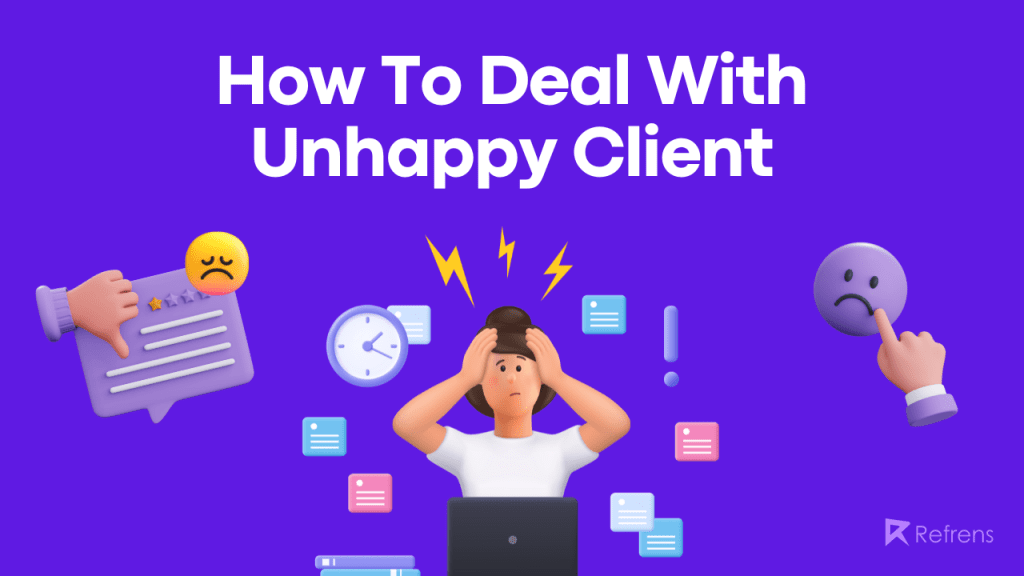“Satisfied customers are the most valuable form of promotion that cannot be purchased with money!”
However, not all freelance clients are always satisfied with your services. As a freelancer, you may have faced instances where you had to handle disgruntled clients, which can be a difficult and nerve-wracking situation. But it also presents a chance to improve the situation and enhance your professional relationship. That’s where the skill of managing client disappointment becomes important.
Dealing with the client’s dissatisfaction is not only about fixing the problem but also about effectively communicating and rebuilding trust. This article will explore the steps necessary to satisfy freelance clients and create a resolution that not only addresses their problems but also makes them feel valued and understood.
These tips are relevant for anyone in the freelancing industry, whether you are a beginner, own a small business, or provide services. They will assist you in transforming a negative experience into a positive one and preserving your professional reputation. But before we dive into the tips, let’s first understand the significance of client satisfaction for success in freelancing.
Why Is Client Satisfaction Important?
In an era of freelancing where freelancers don’t have a “boss”, satisfying clients is the cornerstone of a successful freelancing career. It is the foundation upon which long-lasting, and mutually beneficial relationships are built.
At the heart of client satisfaction is creating a positive and memorable experience. Clients who feel valued, heard, and understood are more likely to trust your expertise, stick with you through any challenges, and recommend you to others.
- What’s at Stake? Reputation!
Unhappy clients can leave negative reviews and spread their dissatisfaction to others, causing damage to your reputation and potentially hurting future business.
By addressing their concerns and resolving the issue, you can maintain a positive reputation and prevent a negative impact on your business. A strong reputation is essential in attracting new clients and retaining existing clients, so it’s crucial to protect it.
- Attracting Repeat Business
It is of no surprise how beneficial a satisfied client can be for your freelance career!
Satisfied clients are more likely to return for future business and recommend your services to others. Turning an unhappy client into a satisfied one increases the chances of repeat business and growth. Repeat business is critical in establishing a steady stream of revenue and securing your future success.
- Opportunity for Improvement
A successful freelance career is always pushed by continuous improvement. And, this is where you can leverage unhappy clients.
Check out how you can improve your skills as a freelancer.
Unhappy clients can provide valuable feedback that can help you identify areas for improvement and make positive changes to your services. By using their feedback to improve, you can enhance your services and increase client satisfaction. Continual improvement is essential in staying ahead of the competition and providing the best possible services to your clients.
Check out the ways you can collect client feedback.
- Building Strong Relationships
Building strong relationships with clients can act as a supercharger for success in the freelance business. These can be essential in retaining clients, attracting new business, and ensuring the longevity of your freelance career. But, it is not as easy as it may seem, and establishing a strong relationship with clients is tough!
By showing empathy, listening to their concerns, and working to resolve the issue, you can build trust and establish a positive relationship with the client.
Once you understand why your client is unhappy and why you need to deal with this issue immediately, the next step is to make them happy and undo the damage! Let’s discuss this in detail!
Recommended read: 10 Things To Do When You Are At Risk Of Losing a Big Client
Unhappy Clients? Understand The “Why”?
Resolving issues with unhappy clients boils down to comprehending why they feel regretful at first. While there can be a range of reasons for this, some of the common reasons for freelancers can be-
- When you “ghost” them without prior notice!
- When you miss the deadline
- When you don’t follow the guidelines properly
- When you don’t meet the expectations
- Changing pricing and availability frequently!
- Overcommitting and under-delivering
Once you identify the “why they are unhappy” aspect, the next is “Understand the ways in which you can deal with these issues”! Working with unhappy clients is a critical aspect of providing quality services and building successful relationships with clients.
But sometimes you can do all correctly. Provide reliable, exceptional work, be proactive in meeting their needs, and communicate effectively and promptly. Despite these efforts, there may be instances when a client becomes dissatisfied. Let’s examine the strategies for handling such circumstances.
Check out ways to juggle multiple clients as a freelancer.
5 Ways To Deal With Unhappy Clients

To begin with, remember that the key to handling unhappy clients is to listen to their concerns, empathize with their situation, and work to find a resolution that meets their needs.
1. Acknowledge their Feedback
The first step is to listen to the client and acknowledge their feelings.
Listening to a client’s perspective and understanding their complaints is crucial in dealing with unhappy clients. By giving them a platform to express their grievances, you show them that their concerns are being heard and valued. This helps establish empathy, which can go a long way in resolving the issue and improving the relationship.
Actively listening to the client also helps you identify the root cause of their dissatisfaction and come up with a solution that addresses their needs. Furthermore, taking the time to understand the client’s perspective demonstrates that you are taking the situation seriously, which can help rebuild trust and increase the likelihood of a positive outcome.
Read more: What’s better? Freelancing vs 9 to 5 jobs
2. Gather More Facts & Understand The Cause
In our experience, the wisest approach is to contain the situation and gather additional information. Assure the client that you will approach the matter objectively and conduct a fair investigation of their complaint or details. Clarify the procedure, the required information, the follow-up schedule, and the path to resolving the issue and offer your business card. Make an extra effort to prevent negative reviews if possible.
Understanding the root cause of the problem is an important step in dealing with client dissatisfaction. By gaining insight into the underlying issue, you can better address the concerns of the client and find a solution that satisfies their needs. Additionally, this approach helps to build trust and establish a more positive relationship with the client in the future.
3. Offer A Constructive Solution
Any new promises won’t make unhappy clients happy. Once you clearly understand the issue, offer a solution that addresses the client’s concerns and seems like logical rectification of their issues! By providing practical and effective solutions, you can resolve the issue and improve the client’s overall experience. This shows that you are committed to the client’s satisfaction and are willing to go the extra mile to make things right.
Here are some examples of constructive solutions that can be offered to clients when they are dissatisfied:
- Provide a discount or credit for future services to compensate for the inconvenience.
- Offer additional services or support to help make up for the problem.
- Provide a detailed explanation of what went wrong and what steps you will take to prevent the same issue from happening again.
- Ask for the client’s feedback and involve them in finding a solution that works for both parties.
- Provide clear and transparent communication throughout the resolution process to keep the client informed and up-to-date.
4. Help Them Feel Heard By Following Up
After concluding the solution, follow up with the client to ensure they are satisfied and the issue has been resolved completely! Any loose ends here can create friction in the future!
By reaching out and checking in with the client, you can show that you care about their experience and are taking steps to address their concerns. This can help to build trust and increase the likelihood that the client will continue to do business with you in the future.
In your follow-up, it’s important to be sincere, empathetic, and solution-focused. Listen actively to their concerns and work to understand their perspective. Provide updates on any steps you have taken to resolve the issue and ask for their feedback on how you can continue to improve their experience. By taking a proactive and collaborative approach, you can help the client feel heard and valued, and increase the chances of a positive outcome.
Check out how you can communicate with a potential client.
5. Learn & Incorporate Futuristic POA
Finally, take the time to reflect on the situation and identify areas where you can improve to avoid similar issues in the future. You can also get creative and create a periodic e-form to gather feedback.
To manage client dissatisfaction in a virtual business setting, it is advisable to have an electronic form for gathering feedback. This approach helps to streamline the process, potentially resolve the issue, and take the matter away from the public eye to prevent escalation.
This way you can also turn your unsatisfied client into a valuable resource for future projects.
What Not To Do When Your Client Is Expressing Dissatisfaction
When dealing with a dissatisfied client, it’s important to avoid certain actions that can make the situation worse. Here are a few things to avoid:
- Interrupting the client: Let the client fully express their concerns and avoid interrupting them. This shows that you are actively listening and taking their situation seriously.
- Getting defensive: It can be tempting to become defensive when a client is expressing dissatisfaction, but this approach can only escalate the situation. Instead, stay calm, listen to the client, and work to understand their perspective.
- Blaming others: Avoid blaming others or making excuses for the problem. This only undermines your credibility and makes the client feel like their concerns are being ignored.
- Ignoring the situation: Don’t ignore the client’s dissatisfaction or hope that it will go away on its own. This can only damage the relationship and harm your reputation.
- Providing vague or insincere responses: Don’t offer vague or insincere responses to the client’s concerns. Instead, be specific and sincere in your communication and provide concrete steps for resolving the issue.
Ready To Gain Some Smiles Through Your Work?
Everyone wants to be proud of the work they do and receive positive testimonials from clients. Gaining smiles from clients through your work can be a great motivator and a sign that you are providing high-quality services. By focusing on meeting client’s needs, providing excellent customer service, and continuously improving your work, you can consistently gain smiles and build strong, positive relationships with your clients.

















